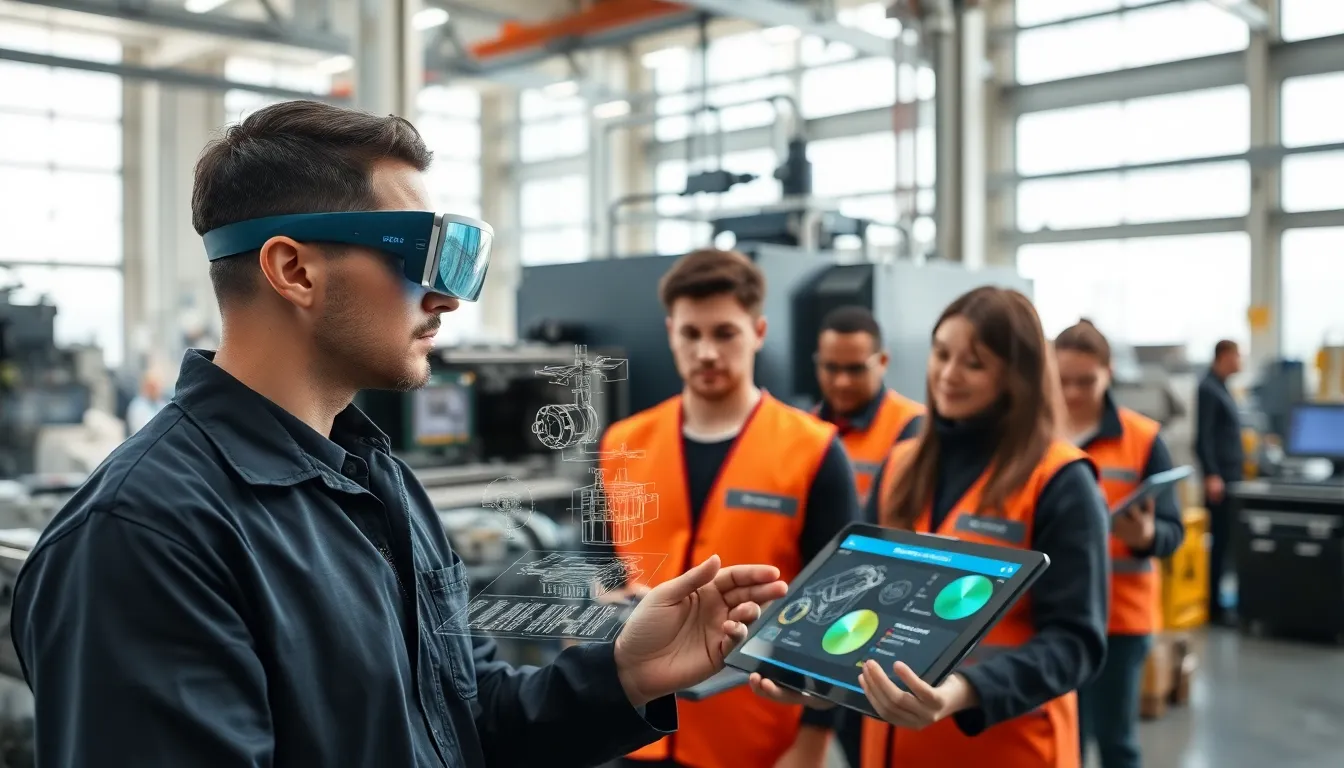Imagine wandering through a factory where robots and workers collaborate seamlessly, guided by digital overlays and real-time data. Augmented reality (AR) in manufacturing is making this vision a reality. It enhances how industries operate, providing real-time information and support, all without the need for sci-fi gadgets. In this text, we’ll jump into what AR is, the benefits it brings, its various applications, and even the obstacles it faces. Buckle up, this is set to be an exciting ride.
Table of Contents
ToggleWhat Is Augmented Reality in Manufacturing?

At its core, augmented reality is about adding digital content to the physical world. In manufacturing, this means overlaying information onto machines, tools, and workflows. Think of it as a guide that shows real-time instructions, updates, or schematics right where they’re needed. For instance, a technician might look through AR glasses and see assembly instructions floating in front of him, directly above the machinery he’s working on. This not only enhances efficiency but also minimizes errors, turning the factory floor into a kind of high-tech playground.
In simpler terms, AR merges the physical and digital realms, providing an enriching experience for workers without diverting their attention from the task at hand. This fine blend between reality and digital enhancement ushers in a new era for manufacturing.
Benefits of Augmented Reality in Manufacturing
The benefits of augmented reality in manufacturing are as varied as they are transformative. Here are some key advantages:
Enhanced Training and Safety
One of the most significant benefits is the impact on training. New employees can learn on the job with AR technology guiding them through processes. This hands-on approach accelerates their learning curve while reducing the likelihood of accidents. Imagine teaching a complex procedure with step-by-step visuals right in front of the trainees, talk about learning on steroids.
Increased Efficiency
Another prime advantage is efficiency. By streamlining workflows and providing real-time guidance, AR helps workers complete tasks more quickly. Industries have observed significant time savings: simple tasks that took hours can now be wrapped up in a fraction of the time. With fewer errors and reduced rework, productivity soars.
Better Collaboration
AR fosters collaboration too, often blurring the line between remote and on-site work. Engineers can project designs in real-time to colleagues, regardless of their physical locations. This collective visualization makes problem-solving a breeze, not to mention the delightful camaraderie that develops when colleagues can team up digitally while remaining in their respective corners of the world.
Applications of Augmented Reality in Manufacturing
Now that we’ve unpacked its benefits, let’s explore how augmented reality is finding its stride in manufacturing.
Maintenance and Repair
One of the most practical uses of AR is in maintenance and repair. When issues arise, technicians can be equipped with AR tools that display diagnostic data and solutions over machinery. This hands-free information can lead to quicker fixes and less downtime, which is a saving grace in high-stakes environments.
Production Line Assembly
Another application is in production line assembly. Workers can access instructions or dimensions right where they need them, ensuring accuracy during assembly. This application minimizes mistakes and maximizes quality assurance, making the transition from design to production smoother than ever.
Quality Control
In quality control, AR technologies allow inspectors to visualize product integrity standards superimposed on the actual product. By comparing real-time data against specifications, manufacturers can maintain high quality, catch defects earlier, and ensure compliance.
Challenges of Implementing Augmented Reality
Of course, it’s not all sunshine and rainbows in the world of augmented reality. Implementation can face several challenges:
High Initial Costs
One of the most significant barriers is the initial investment. Implementing AR technology requires not only high-quality hardware but also training personnel to use it effectively. This can create a hefty upfront cost that smaller manufacturers may find daunting.
Integration with Existing Systems
Incorporating AR technology into existing workflows can also be complicated. Compatibility with older systems and machinery can pose substantial hurdles, requiring extensive time and effort to sync everything up seamlessly.
Technological Limitations
Finally, there are technological limitations. AR requires robust networking and infrastructure. A lack of reliable connectivity or insufficient computing power can hinder the efficiency of AR applications, stunting their true potential in the manufacturing landscape.
Future Trends in Augmented Reality for Manufacturing
So, what’s next for AR in manufacturing? Buckle in as we gaze into the crystal ball.
Increased Use of AI
The future will likely see augmented reality merging with artificial intelligence to create even smarter manufacturing processes. This combo can lead to predictive maintenance, where machines self-diagnose issues before they become severe, a kind of health checkup but for machinery.
Enhanced Customization
Also, as customers demand more tailored products, AR will likely allow manufacturers to visualize and plan custom designs directly on the production floor. This demand for personalization will brighten the prospects for AR technologies.
Broader Adoption
Finally, as costs decrease and success stories proliferate, expect broader adoption throughout the industry. From automotive to aerospace, firms will increasingly recognize AR as not just a novelty but a necessity in optimizing operations.


